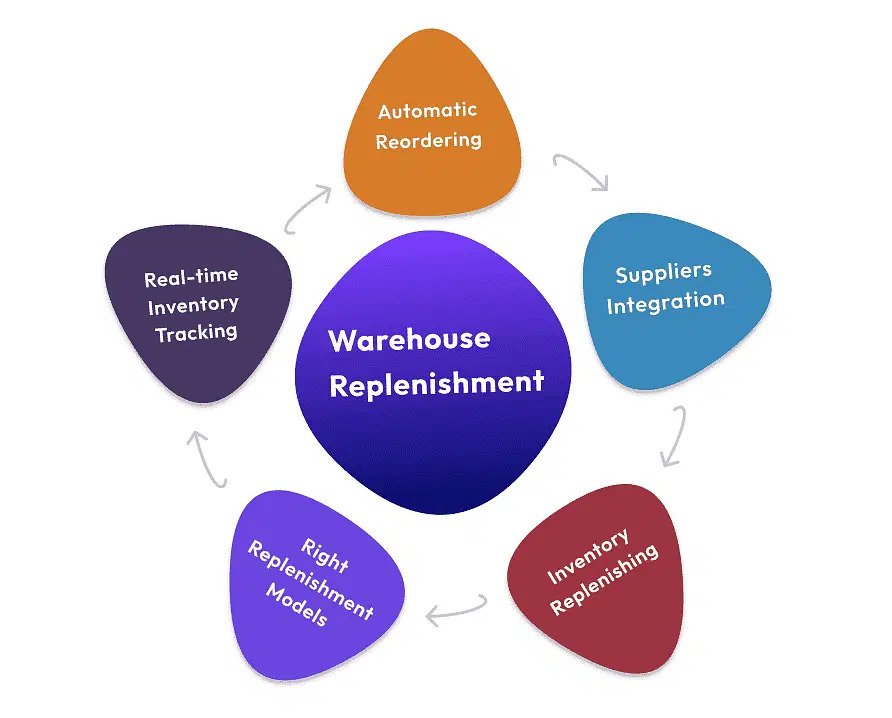Benefits Of Warehouse Management System (WMS) Inventory With On-Demand Replenishment
In today’s fast-paced business world, managing warehouse inventory efficiently can be a real challenge. Keeping track of stock levels, fulfilling customer demands promptly, and avoiding costly stockouts are all crucial aspects of successful inventory management. This is where the power of On-Demand Replenishment comes into play, revolutionizing the way warehouses operate. By integrating Warehouse Management Systems (WMS) with On-Demand Replenishment, businesses can streamline their inventory processes and enjoy a host of benefits. In this blog, we’ll delve into the advantages of adopting this innovative approach, understand how it works, and explore essential tips to optimize the warehouse replenishment process.

What is Warehouse Replenishment?
Despite the fact that these two terms have different meanings, warehouse replenishment, and fulfillment are frequently used synonymously. From the supplier to the final consumer, warehouse fulfillment transports the product. A company, a production facility, a retail outlet, a distributor, or the final customer could all be this client.
On the other hand, warehouse replenishment describes one of two situations:
Warehouse replenishment, in the first place, is the process of restocking your warehouses with goods that your business frequently orders from outside sources. The decision to resupply the warehouse in this instance is between you and your vendor, not your consumer.
Second, warehouse replenishment can refer to relocating materials within your warehouse to various processing or storage sites so that you have them ready to fulfill customer orders.
When your products need to be reordered in order to prevent stock shortages, warehouse replenishment is required.
Your re-order points can be simply determined using an inventory management system based on the specifications set out by your business for each of its products.
What is the Purpose of Replenishment?
The primary purpose of warehouse replenishment is to ensure that products are available when customers need them. By keeping stock levels in check and replenishing inventory promptly, businesses can strike a balance between meeting customer demands and managing costs effectively. The ultimate goal is to provide seamless service to customers while avoiding the pitfalls of overstocking or running out of essential products.
Revitalize your inventory with seamless Warehouse Replenishment solutions, ensuring products are stocked and operations flow effortlessly. Optimize stock levels today for a future of efficient supply chain success.
Benefits of Efficient Warehouse Replenishment
Improved Inventory Accuracy:
Adopting a Warehouse Management System with On-Demand Replenishment brings greater accuracy to inventory management. Real-time tracking and automated processes minimize human errors, ensuring that stock levels are more precise and reducing discrepancies in inventory records.
Increased Productivity:
With On-Demand Replenishment, warehouse staff can work more efficiently. Automation streamlines repetitive tasks, allowing employees to focus on more value-added activities, which leads to higher productivity and smoother warehouse operations.
Cost Savings:
Efficient replenishment practices can lead to significant cost savings for businesses. By replenishing inventory on demand, companies can avoid tying up capital in excess stock. On the other hand, avoiding stockouts helps prevent lost sales opportunities and potential dissatisfied customers.
Enhanced Customer Satisfaction:
Customer satisfaction is vital to any successful business. On-Demand Replenishment ensures that orders are fulfilled promptly, leading to happier customers who receive their products on time.
Better Demand Forecasting:
A Warehouse Management System with On-Demand Replenishment provides valuable data on inventory movement and customer demand. By analyzing this data, businesses can improve their demand forecasting, making it easier to anticipate customer needs and adjust inventory levels accordingly.

How Does Warehouse Replenishment Work?
Real-time Inventory Tracking:
On-Demand Replenishment relies on real-time inventory tracking using technologies like barcodes, RFID, or IoT devices. These tracking systems continuously monitor stock levels and provide up-to-the-minute information on inventory movement.
Automatic Reordering:
When stock levels fall below predetermined thresholds, the Warehouse Management System automatically triggers the replenishment process. This automation ensures that inventory is replenished in a timely manner, reducing the risk of stockouts and preventing delays in fulfilling customer orders.
Integration with Suppliers:
Efficient On-Demand Replenishment requires seamless integration with suppliers and vendors. Electronic Data Interchange (EDI) and other communication protocols enable quick and efficient order processing between the warehouse and suppliers.
Regular Inventory Replenishing
When inventory levels drop below the pre-determined minimum threshold, this model issues replenishment orders. When there is large product storage and longer lead periods, the periodic inventory replenishment is typically employed.
Finding the Right Combination of Replenishment Models
For optimal warehouse operations, selecting the best replenishment model is essential. When it comes to achieving and maintaining the ideal balance between customer demand and safe inventory levels, especially during times of strong demand, an eCommerce business will frequently benefit from adopting several replenishment models.
Tips to Optimize Your Warehouse Replenishment Process
Embrace Automation: Invest in a reliable Warehouse Management System that automates the replenishment process. Automation reduces manual errors and speeds up order processing, contributing to a more efficient warehouse operation.
- Set Optimal Reorder Points: Analyze historical data and demand patterns to determine the best reorder points for each product. This ensures that replenishment occurs at the right time, preventing stockouts and overstocking.
Collaborate with Suppliers: Develop strong partnerships with suppliers and vendors. Effective communication and collaboration can lead to faster order processing and better inventory management throughout the supply chain.
Continuous Monitoring and Improvement: Regularly monitor the performance of your replenishment process. Analyze data and identify areas for improvement to continuously optimize efficiency and responsiveness to customer demands.
Wrapping It Up
On-Demand Replenishment, powered by Warehouse Management Systems, has emerged as a game-changer in the world of inventory management. The benefits of improved accuracy, increased productivity, cost savings, and enhanced customer satisfaction are compelling reasons for businesses to adopt this innovative approach. By automating processes and optimizing inventory levels, companies can gain a competitive edge and build stronger relationships with their customers. As the business landscape continues to evolve, the adoption of On-Demand Replenishment is the key to simplifying warehouse inventory management and creating a more customer-centric future.
About the Brand: Silent Infotech is a leading innovator, specializing in providing cutting-edge warehouse inventory management systems. With a customer-centric approach, they revolutionize how businesses manage their inventory, ensuring real-time tracking, increased accuracy, and seamless operations. Experience efficiency like never before with Silent Infotech’s top-notch solutions.